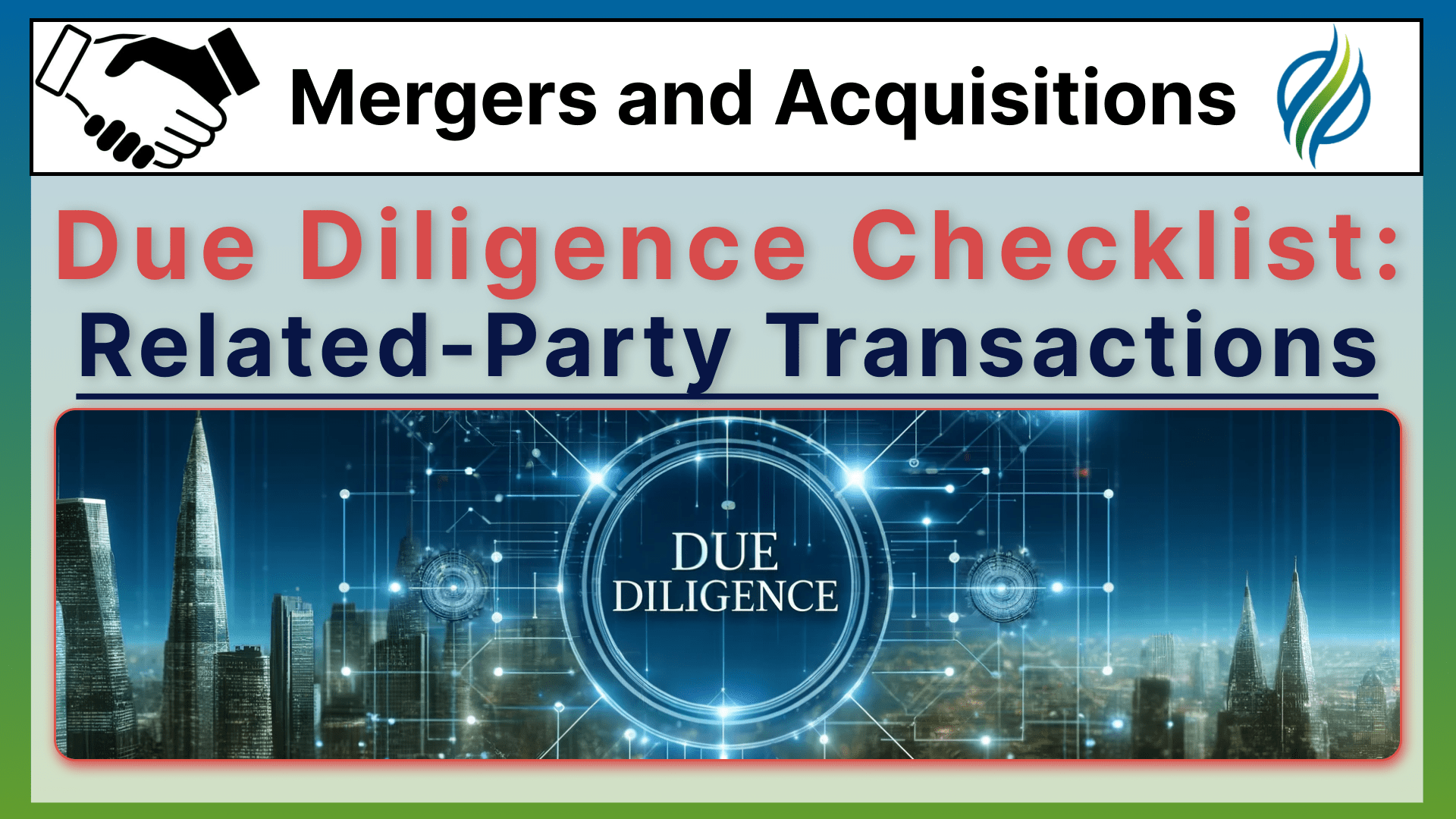Understanding related party transactions is crucial in M&A due diligence.
These transactions involve deals between a company and its insiders.
They can reveal conflicts of interest and impact the fairness of business operations.
 Key Takeaways
Key Takeaways
- Identify direct and indirect interests of key insiders to spot potential conflicts.
- Review compensation agreements for transparency and fairness in company practices.
- Examine related party asset ownership to uncover risks and conflicts.
- Ensure all related party transactions are properly disclosed and legally compliant.
- Regularly monitor and document related party dealings for ongoing compliance and transparency.
This article explains the importance of identifying and managing these transactions.
It provides practical steps to review and assess them.
You’ll learn how to ensure transparency and compliance in your due diligence process.
Read on to get the most out of this guide.
It’s packed with practical tips and self-assessment questions.
Ensure your M&A process is thorough and fair.
Continue reading to master related party transactions in M&A.
 Table of Contents
Table of Contents
Understanding the extent of any “related party” transactions is crucial in mergers and acquisitions (M&A) due diligence.
These transactions involve agreements or arrangements between the target company and any current or former officer, director, stockholder, or employee.
By thoroughly examining these relationships, you can uncover potential conflicts of interest, assess the fairness of business dealings, and ensure compliance with relevant laws and regulations.

➤ MORE: Check out the FULL Due Diligence Checklist here
Identify Direct or Indirect Interests:
Reviewing direct or indirect interests of officers, directors, stockholders, or employees in businesses that compete with or do business with the company is essential.
This helps identify potential conflicts of interest, which could affect the target company’s operations and strategic decisions.
Understanding these interests ensures that any potential biases or preferential treatments are disclosed and managed properly.
Practical Benefits:
-
Identifies potential conflicts of interest that may impact business decisions.
-
Ensures transparency in business operations.
-
Helps in evaluating the integrity and fairness of management practices.
Importance:
-
Conflicts of interest can lead to biased decision-making.
-
Transparency in interests promotes trust and fairness.
-
Proper management of these interests is crucial for legal compliance and ethical standards.
Practical Steps:
-
Collect and Review Disclosures: Gather all disclosures related to interests in competing businesses or business dealings with the company. Analyze these disclosures to understand the nature and extent of the interests.
-
Interview Key Personnel: Conduct interviews with officers, directors, and significant stockholders to gather insights into their external business interests.
-
Analyze Business Relationships: Assess how these interests could potentially conflict with or influence the company’s business operations and strategic decisions.
-
Evaluate Conflict Management: Review how the company manages potential conflicts of interest, including policies and procedures in place to handle such situations.
Self-Assessment Questions:
-
Are there any related parties with interests in competing businesses?
-
What is the nature and extent of these interests?
-
How does the company manage potential conflicts of interest?
-
Are there any disclosures or agreements related to these interests?
Links to Resources:
Review Compensation Agreements:
Obtaining copies of agreements where any officer, director, stockholder, or employee is entitled to compensation is crucial.
This ensures transparency and fairness in compensation practices, which are vital for maintaining trust and integrity within the organization.
Scrutinizing these agreements helps in understanding the financial commitments and obligations towards related parties.
Practical Benefits:
-
Ensures fair and transparent compensation practices.
-
Helps in assessing financial obligations towards key personnel.
-
Identifies any potential issues or disputes related to compensation.
Importance:
-
Fair compensation practices are crucial for employee morale and retention.
-
Transparency in compensation agreements fosters trust among stakeholders.
-
Identifying disputes early can prevent future legal and financial issues.
Practical Steps:
-
Obtain Compensation Agreements: Collect all compensation agreements involving officers, directors, stockholders, and employees.
-
Compare with Industry Standards: Assess whether these agreements are consistent with industry norms and standards.
-
Evaluate Transparency: Ensure that the terms of compensation are transparent and well-documented.
-
Investigate Disputes: Look into any disputes or issues related to these agreements to understand potential risks.
Self-Assessment Questions:
-
What compensation agreements are in place for related parties?
-
Are these agreements consistent with industry standards?
-
How transparent are the company’s compensation practices?
-
Are there any disputes or issues related to these agreements?
Links to Resources:
Examine Asset Ownership and Transactions:
Reviewing agreements where a related party has an interest in any asset of the company, such as real estate, intellectual property, or personal property, helps identify potential risks and conflicts.
These examinations ensure that all asset transactions are conducted fairly and transparently, safeguarding the company’s interests and complying with legal standards.
Practical Benefits:
-
Identifies potential conflicts of interest in asset ownership.
-
Ensures fair and transparent asset transactions.
-
Helps in evaluating the integrity of asset management practices.
Importance:
-
Conflicts in asset ownership can lead to legal and financial complications.
-
Transparency in asset transactions fosters stakeholder trust.
-
Proper documentation and disclosure of asset ownership are crucial for legal compliance.
Practical Steps:
-
Gather Asset Agreements: Collect all agreements where related parties have an interest in company assets.
-
Analyze Ownership Interests: Review the nature and extent of these ownership interests.
-
Assess Documentation: Ensure that ownership interests are properly documented and disclosed.
-
Evaluate Risks: Identify any risks or conflicts associated with these assets and assess measures in place to manage them.
Self-Assessment Questions:
-
What assets are owned or partially owned by related parties?
-
How are these ownership interests documented and disclosed?
-
Are there any risks or conflicts associated with these assets?
-
What measures are in place to manage related party transactions?
Links to Resources:
Assess Disclosure and Compliance:
Verifying that all related party transactions are properly disclosed and compliant with applicable laws and regulations is fundamental.
This ensures transparency and reduces legal risks, safeguarding the company’s reputation and financial stability.
Proper disclosure and compliance demonstrate the company’s commitment to ethical practices and legal standards.
Practical Benefits:
-
Ensures transparency and ethical business practices.
-
Reduces legal risks associated with undisclosed transactions.
-
Demonstrates compliance with relevant laws and regulations.
Importance:
-
Non-compliance can lead to significant legal and financial repercussions.
-
Transparency in disclosures promotes stakeholder trust.
-
Proper documentation and review of transactions are essential for regulatory compliance.
Practical Steps:
-
Verify Disclosures: Check that all related party transactions are disclosed in financial statements and other relevant documents.
-
Ensure Compliance: Assess whether these transactions comply with relevant laws and regulations.
-
Ongoing Compliance Monitoring: Implement procedures for ongoing monitoring and compliance with disclosure requirements.
-
Document Review Processes: Review how the company documents and reviews related party transactions to ensure accuracy and completeness.
Self-Assessment Questions:
-
Are all related party transactions properly disclosed?
-
Are these transactions compliant with relevant laws and regulations?
-
How does the company ensure ongoing compliance with disclosure requirements?
-
Are there any potential legal risks related to undisclosed transactions?
-
How does the company document and review related party transactions?
Links to Resources:
FAQs - Frequently Asked Questions About Due Diligence into a Company’s Related Party Transactions

What are related party transactions in M&A?
They are agreements between the company and insiders like officers, directors, or shareholders.
These transactions can reveal conflicts of interest.
Learn More...
Related party transactions in M&A involve deals between the company and its insiders, such as officers, directors, stockholders, or employees.
These transactions are crucial to examine as they can uncover potential conflicts of interest and ensure that business operations remain fair and transparent.
- Examples include loans to directors, sales to affiliated companies, or compensation agreements.
Properly identifying and managing these transactions helps in maintaining trust and integrity in the company's financial practices.
Why is it important to identify direct or indirect interests in related party transactions?
It helps uncover conflicts of interest.
Ensures transparency and fairness.
Learn More...
Identifying direct or indirect interests in related party transactions is vital to uncover potential conflicts of interest that could bias decision-making and impact the company's operations.
By reviewing these interests, companies can ensure transparency, which is essential for maintaining stakeholder trust and adherence to ethical standards.
This practice also helps in evaluating the fairness of business practices and aligning them with legal and regulatory requirements.
How do compensation agreements affect M&A due diligence?
They ensure fair and transparent compensation practices.
Highlight financial obligations to key personnel.
Learn More...
Compensation agreements are crucial in M&A due diligence as they ensure transparency and fairness in how key personnel are compensated, which is essential for maintaining trust within the organization.
By reviewing these agreements, you can assess the financial obligations the company has towards its officers, directors, stockholders, or employees, ensuring that these are in line with industry standards and legal requirements.
This review helps in identifying any potential disputes or issues that could arise from these agreements, allowing for proactive management and resolution.
What steps should be taken to examine asset ownership in related party transactions?
Gather and review all relevant agreements.
Assess the documentation and disclosure of ownership interests.
Learn More...
To examine asset ownership in related party transactions, first gather all agreements where related parties have an interest in company assets such as real estate, intellectual property, or personal property.
Analyze these agreements to understand the nature and extent of ownership interests, ensuring that all such interests are properly documented and disclosed.
- Identify any risks or conflicts associated with these assets.
- Evaluate measures in place to manage related party transactions.
This thorough examination helps in mitigating potential risks and ensuring fair business practices.
Why is ongoing compliance important in managing related party transactions?
It ensures transparency and legal adherence.
Reduces legal risks and promotes trust.
Learn More...
Ongoing compliance in managing related party transactions is essential for maintaining transparency and adhering to legal standards, which helps in reducing legal risks and fostering trust among stakeholders.
Regularly monitoring and documenting these transactions ensures that the company stays compliant with relevant laws and regulations, thereby avoiding potential legal and financial repercussions.
This practice demonstrates the company's commitment to ethical business practices and enhances its reputation for integrity and fairness.
What resources are available for learning more about related party transactions?
Refer to SEC filings and internal audit reports.
Consult corporate legal counsel and industry guides.
Learn More...
For a deeper understanding of related party transactions, you can refer to the SEC EDGAR Database for public companies' financial filings and internal audit reports for insights into audit processes and risk management.
Consulting corporate legal counsel can provide detailed reviews and compliance strategies, while industry guides from sources like the Harvard Law School Forum on Corporate Governance offer valuable insights.
These resources help in gaining a comprehensive view of managing and documenting related party transactions effectively.
In Summary…
In mergers and acquisitions (M&A) due diligence, understanding and managing related party transactions is vital.
By thoroughly identifying and assessing direct and indirect interests of key insiders, you can spot potential conflicts that may impact business operations.
Reviewing compensation agreements ensures transparency and fairness, while examining related party asset ownership helps uncover risks and conflicts.
Ensuring proper disclosure and compliance with legal standards protects the company’s integrity and financial stability.
Regular monitoring and documentation of related party transactions maintain ongoing compliance and transparency.
Applying this information can significantly improve your M&A due diligence process.
By implementing the practical steps outlined, you gain a clear understanding of potential conflicts of interest, ensure fair compensation practices, identify and manage asset-related risks, and maintain legal compliance.
This thorough approach not only safeguards your company’s interests but also builds trust among stakeholders and enhances decision-making.
To gain deeper insights and tailored advice for your M&A process, with us schedule a consultation call or use our contact form.
Stay informed and ahead of the curve by subscribing to the Initiative Newsletter for the latest updates and expert guidance.
Follow Business Initiative on X for real-time updates into the world of M&A due diligence and much more…
Enhance your M&A strategy with expert insights and practical steps by connecting with us today.
Sources
- SEC Filings on Related Party Transactions: For public companies' disclosures.
- Internal Audit Reports Guide: Comprehensive guidance on internal audit processes and risk management.
- Harvard Law School Forum on Corporate Governance: Insights on corporate governance and conflicts of interest.
- Mercer Compensation Benchmarking Reports: Industry standards for compensation practices.
- SEC Proposed Rules on Executive Compensation: Transparency in executive compensation.
- American Arbitration Association - Compensation Disputes: Resources for resolving compensation-related disputes.
- PwC Global Asset Management Benchmarking Report: Best practices in asset management.
- USPTO Intellectual Property Policy: Guidance on intellectual property transactions.
- National Association of Realtors - Related Party Transactions: Resources on real estate transactions involving related parties.
- SEC Guidelines on Related Party Disclosures: Regulatory guidelines for related party disclosures.
- Deloitte Risk Management Frameworks: Comprehensive risk management and compliance strategies.
- COSO Internal Controls Framework: Best practices for internal controls and compliance.


